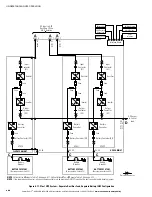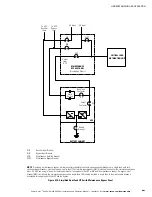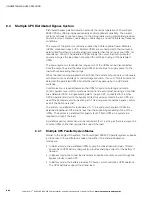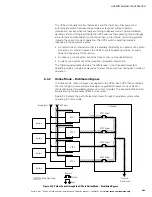
UNDERSTANDING UPS OPERATION
Power Xpert
9395 UPS (450–550 kVA) Installation and Operation Manual
164201701 Rev 3
www.eaton.com/powerquality
6-25
In a distributed bypass system, each UPS operates similar to a single UPS, but in
parallel with each other. The bypass source for the load is derived from the bypass
input of one, two, three, or four UPSs, depending on the system configuration,
through the internal static switches. If a module is taken offline, the other modules
remain online to support the load. If more modules than can support the load must be
taken offline, the load must be transferred to maintenance bypass or shut down.
The distributed bypass system can be transferred from Normal mode to Bypass mode
manually. However, the distributed bypass system automatically switches to Bypass
mode whenever the UPSs can no longer supply the critical load. If the distributed
bypass system transfers to Bypass mode from Normal mode due to an output voltage
deviation, the distributed bypass system automatically attempts to return to Normal
mode (up to three times within a 10‐minute period). After three transfer attempts or
an overload, the system locks the critical load to the bypass source and requires
operator intervention to transfer.
Bypass mode is a normal operating mode, not an alarm condition. However, if the
distributed bypass system is unable to return to Normal mode following an automatic
transfer to Bypass mode, an alarm condition is recorded.
Bypass may also be used when the UPSs or UPMs in the system must be shut down
to perform routine maintenance or repairs.
In the Parallel Redundant (N+1) arrangement, the bypass circuitry in each UPS
operates to support the applied loads on bypass. If the UPSs are in ONLINE and one
UPS trips offline, the remaining UPSs do not go to bypass as long as they have the
capacity to support the load.
In the Parallel Capacity (N+0) arrangement, if one UPS trips offline and goes to
bypass, the remaining UPSs also go to bypass.
6.4.4
Battery Mode – Distributed Bypass
The UPSs transfer to Battery mode automatically if a utility power outage occurs, or if
the utility power does not conform to specified parameters. In Battery mode, the
battery provides emergency DC power that the inverter converts to AC power.
Figure 6‐21 shows the path of electrical power through the distributed bypass system
when operating in Battery mode.
While in Battery mode, the UPSs sound an audible horn, illuminate a visual indicator
lamp on the front panel (Online and On Battery), and create an entry into the alarm
event history. As the battery discharges, the boost converter and inverter constantly
make minute adjustments maintaining a steady output. The UPSs remain in this
operating mode until the input power to the rectifier is again within the specified
voltage or frequency acceptance windows.
















































